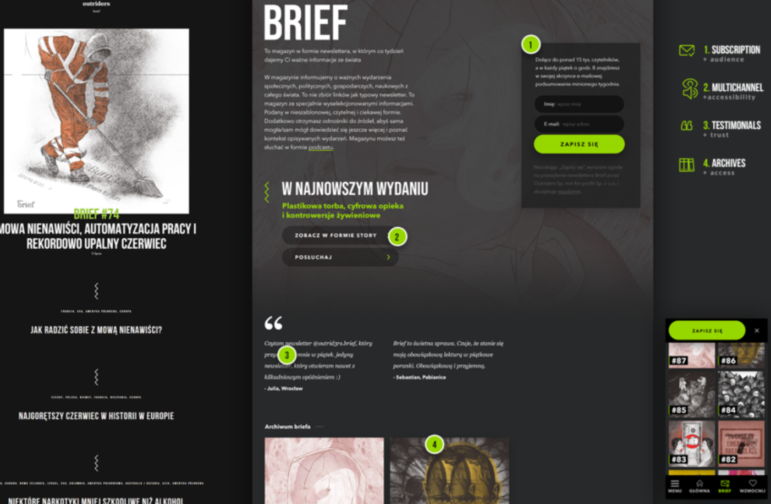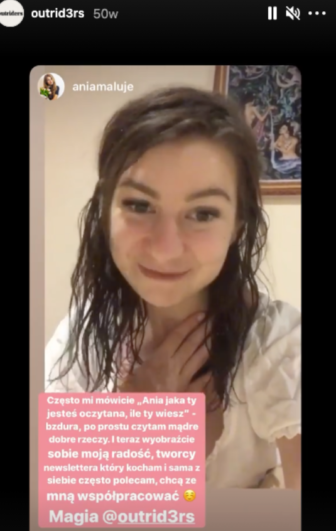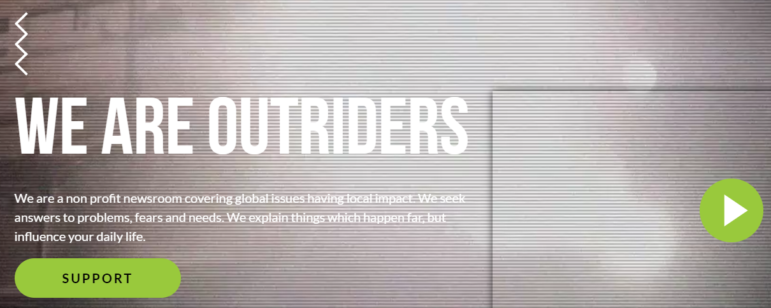Outriders launched in 2017 at a deeply polarized moment in Poland. It was two years after a conservative, populist government came to power, sparking civil unrest among more liberal Poles with many of its reforms.
Journalists Jakub Górnicki and Anna Górnicka were concerned with the way that national turmoil was drawing Poles inward and crowding out thoughtful debate. They launched Outriders to help Poles understand how global issues affect them, and to discuss them with proper context.
“A division into local issues and world affairs does not exist any longer,” they explained in their editorial policy. “All humankind faces the same challenges. We want to better understand the reality around us and share this knowledge with you.”
They quickly gained a loyal following for Outriders Brief, their visually gripping, magazine-style weekly newsletter that provides nonpartisan, in-depth international coverage from a Polish perspective. Their value proposition was clear, and their earliest newsletter subscribers loved Brief. They knew they had a strong foundation for membership.
But they didn’t have enough readers yet — nor insight into how they acquired them — to confidently launch a membership program. So in 2018 they decided to postpone their membership launch and focus instead on Brief, pivoting to a newsletter-first editorial strategy to grow their loyal audience and build a strong foundation for membership.
By the end of 2020, they had grown Brief to more than 35,000 subscribers — an increase of 24,000 in less than two years — and signed up 8,000 people to a second newsletter that they launched. After a pandemic-driven postponement, they launched their membership program in December 2020.
Many newsrooms rush to launch a membership program, skipping a critical prerequisite: developing and getting to know their loyal audience. This case study will walk you through the steps they took to first put Brief at the center of the readers’ experience and then aggressively grow that newsletter list, laying a strong foundation for membership.
The Path to Becoming Newsletter-First
In November 2017, Outriders held a crowdfunding campaign to launch a new newsletter focused on global issues. They raised 85,000 Polish zloty (or PLN, about $22,900).
The team soft-launched Brief in January 2018, first sending it to the 600-plus people who contributed to the crowdfunding campaign. They launched publicly in March 2018, quickly gaining 7,000 subscribers.

The Brief newsletter landing page, with 1) a newsletter signup box, 2) secondary channels to “subscribe” (in this case, to follow their Instagram Stories), 3) testimonials from readers, and 4) an archive of past issues. Image: Screenshot
The Outriders team decided to make Brief the cornerstone of their work because they were insistent that they be algorithmically independent, and able to create a direct, personal relationship with their audience, Górnicki said. They wanted Brief to be the main entry point to a diverse community of readers capable of debating issues affecting Polish society.
Brief would provide a common onboarding experience for all readers, establishing solid ground for a lasting relationship. “The newsletter gave us a lot of possibilities. No change in any platform can take this relationship away from us,” he said.
Next, they focused on a site redesign and brand consistency. Brief’s artistic, magazine-style esthetic had long been one of Outriders’ most recognizable features, but that attention to visual detail was inconsistent across its different platforms and products. They wanted everything readers encountered to feel like a continuation of their brand, and to point them toward Brief as the central Outriders experience.
At the same time, they shifted their core metric for success from site visitors to newsletter subscribers. That meant funneling readers to the newsletter signup page rather than individual stories. They redesigned the website to showcase Brief more prominently. They made sure that the sole call-to-action anywhere on their properties was for readers to sign up for the newsletter, and began paying close attention to sign-up pathways and unsubscribe numbers.
To support this shift in strategy, the team worked with a designer who specialized in e-commerce to maximize conversions on their site without compromising the visual identity. They designed an onboarding series to drive home the point that the Outriders experience begins when someone subscribes to Brief.

An edition of Brief, with 1) a table of contents of all the stories in the current issue (mobile version in the smaller box in the bottom right), 2) left-aligned font for better online reading, 3) larger fonts for reading ease, and 4) the same newsletter signup box as above. Image: Screenshot
They also changed the way they defined and cultivated engagement. Rather than seeking to create public “debates” on their platforms, which would usually devolve into fights, they focused on cultivating one-on-one interactions through replies to the newsletter, where they could disagree but still have a conversation. Although these one-on-one conversations were more time consuming, they were also more rewarding for both Outriders and its readers. The staff started paying attention to engagement metrics such as how many people replied to the Brief each week and whether each person received a reply.
Doubling Down
Once the Outriders team made the design and workflow changes to become newsletter-first, they focused on growing their list and deepening engagement with readers.
They did this by:
- Tracking subscriber acquisition more systematically in order to make data-informed decisions about where to invest their resources.
- Improving their onboarding process and conducting audience surveys.
- Expanding their engagement efforts through campaigns that leveraged the brand’s strong visual identity and spread their anti-polarization editorial values.
Identifying Opportunities for Growth
First, the team streamlined the newsletter’s acquisition strategies and put a data tracking system in place. They did this by:
- Mapping every place a user could sign up to Brief, including each weekly issue, landing pages, social media posts (both organic and paid), Google AdWords, and cross-promotion with other publications’ newsletters.
- Assigning a UTM tracking code to each of the above entry points, allowing them to track the performance of each call-to-action and subsequently compare them.
- Reviewing the performance of each entry point every two weeks to determine which ones were most effective at acquiring new subscribers, as well as analyzing what led users to unsubscribe.
- Running a subscriber survey to determine how and why readers signed up.
- Using all of the above to reprioritize their acquisition strategies and draft a new strategy.
Studying the acquisition data revealed, for example, that Facebook was not an effective platform for them to acquire new subscribers. Instagram performed much better, with 30% of traffic to the Brief landing page coming from Instagram. The team significantly reduced its efforts on Facebook and concentrated on organic growth through Instagram. (This happened around the same time that Facebook made changes to its algorithm, reducing the effectiveness of Facebook pages.)
Follow-up surveys sent to new subscribers revealed a powerful acquisition pathway that quantitative data alone didn’t show: 15% of their readers said they subscribed as a result of a friend’s recommendation. When the team started paying more attention to sharing and recommendation behavior, they noticed that many readers took screenshots of the Brief when it arrived every Friday and shared it on their Instagram Stories.
“Basically we discovered that almost 15% of our readers were coming through a funnel that we didn’t create,” Górnicki said. “But it was invented for us by our readers, who were using their own social media reach to recommend us, organically.”
Another 30% of subscribers first learned of the Brief because it was recommended on Instagram by one of many Polish social media influencers who were early fans of Outriders.

An example of a post by a Polish influencer about Brief. Image: Screenshot
To capitalize on this, Outriders consolidated its Polish and English-language Instagram accounts into one account and got it verified so that they could gain the “Swipe up” function. Now, five out of eight news items featured in each edition of Brief are turned into Instagram Stories that encourage followers to sign up for Brief to get the full Outriders experience.
Outriders now relies on Instagram to keep readers engaged between the weekly release of the magazine, which also helps build reader habits and loyalty. Instagram is the only social media platform Outriders recommends in its email newsletters, and they encourage enthusiastic followers to sign up for the newsletter to deepen their relationship.
Their Stories also feature other projects, like the Migration Monitor, their international migration status tracker; Unblock, which provides updates from Ukraine and Belarus; and Radar, which showcases responses and solutions to the coronavirus pandemic.
Onboarding Subscribers
Outriders then developed an onboarding series to deepen the relationship with these new readers. They initially planned a four-email series:
- A welcome email from editor-in-chief Anna Górnicka, greeting the new subscribers, introducing them to the publication’s values, and telling them what they can expect from the Brief.
- Ten days from signup: an e-mail from Jakub Górnicki explaining Outriders’ editorial process.
- Twenty days from signup: an email that introduces the reader to the rest of the team and explains Outriders’ financial model.
- Thirty-five days from signup (after they’ve received four issues of the Brief): an email inviting them to become members.
Initially, Outriders was worried that the onboarding was going to be too long, and decided to merge the second and third emails, which would cut down the process to three emails.
Despite a high open rate of more than 52% across the first two onboarding emails, readers said that the narrative was confusing. Many replied asking for clarifications, especially after the Outriders team merged the emails explaining their editorial process and financial model. The team decided to go back to the original four-email series. Most of the feedback they get to the onboarding series now is from satisfied readers who have joined the Outriders ecosystem.
Growing and Diversifying their Readers with Influencers
For Outriders, their anti-polarization mission isn’t just about political polarization — it’s also about reaching people who wouldn’t normally seek out something like Brief.
According to an audience survey conducted in spring 2019, Outriders’ readers are predominantly female, between 26 and 40 years old. They live in both big cities and smaller villages, and almost 20% don’t have a university degree. This audience overview matches Outriders’ mission of discussing global issues with a diverse audience, not just a high-income, highly educated audience living in big cities.
But Outriders still reaches mostly highly educated, middle- and upper-class readers, mostly living in medium and large cities in Poland. That doesn’t align with their goal of bringing together people who don’t always agree, and finding ways for them to talk to each other.
To change that, they identified the following target groups outside the publication’s natural comfort zone:
- Men younger than 25 years old.
- Women from cities with fewer than 100,000 residents.
- Mothers younger than 30 years old.
They reached these groups by working with influencers with whom founders Górnicki and Górnicka had longstanding relationships from a popular blog they wrote prior to Outriders. Some of those influencers had already helped fuel Outriders earlier growth simply because they enjoyed reading it.
Górnicki and Górnicka understood that digital companies must exude a feeling of community to gain followers, and saw how influencers cultivated and leveraged that feeling to grow their following. Outriders had already successfully branded itself as a community you can join, rather than a distant institution. In the polarized Polish climate, people don’t trust institutions, but they do trust other people, Górnicki noted.
For all these reasons, Outriders was well positioned to tap into the power of influencers to grow its newsletter base.
Although influencers can have a reputation for shady financial relationships and peddling misinformation, Górnicki and Górnicka knew that this was not true across the board. Some of those they knew wanted to use their reach to build support for causes. So Outriders got in touch with several female influencers, including @kasiagandor, who is followed for her science expertise, and @aniamaluje, who was followed for her pre-pandemic travel experiences.
“We want to show that the global issues we cover are not just for white old guys working in think tanks,” Górnicki explained. “We want to show people that these issues are around all of us, each of us, and they influence our lives.”
They worked with several influencers, entering into a formal financial agreement with each — not all that different from when a news organization pays for conventional advertising. Each agreement required two separate mentions of Brief on IG stories and a swipe up link to the subscription page. The influencers followed standard Instagram guidelines for disclosing when content is sponsored content.
The influencer strategy proved to be much more effective than Facebook lead generation advertising. It boosted Brief subscriptions from 10,000 in 2018 to 30,000 in February 2020, and their Instagram following from 10,000 to 16,000, helping Outriders increase the overall conversion rate on the platform via their own account.
Around the same time, Outriders launched its LoveSpeech campaign to create a “special language to debate polarizing issues.” The campaign consisted of a set of hand-drawn gifs released on GIPHY that could be used on several social platforms. At the time of writing, the gifs had 8.8 million views on GIPHY.
The Membership Launch
Outriders’ goal was to build a strong, direct relationship with their audience through Brief, with the ultimate goal of launching their membership program, Outriders World.
By February 2020, their newsletter list had grown to more than 30,000 subscribers, with an open rate of 39.5%. Outriders felt ready to launch and planned to do so in spring 2020.
But the coronavirus pandemic eliminated two crucial elements of World. The first was “Festiwal,” a June 2020 event that would have been part music festival, part conference, featuring performances, art installations, meetings with creators, and panels. The other element was partnerships with companies who would provide special offers to Outriders members. Festiwal had to be postponed, and companies signaled they would have to wait until the end of the crisis to reassess their needs and ability to participate in the program.
Between the pandemic and a fourth election in just two years, the Outriders team sensed that Poles felt like they were in a never-ending campaign season. They decided it would be too hard to cut through the noise and paused the launch of its membership scheme.
But as the pandemic dragged on, they realized they couldn’t afford to wait any longer. Instead, they decided to embrace the circumstances of the launch and built their launch campaign around their effort to help people adapt to the uncertainty of the world in 2020.
They soft-launched in November 2020 with the message “The world is a mess. We help you make sense of it.” In just one weekend, they gained 212 new members. By their official launch on December 9, they had 349, and at the end of January 2021, they were at 467.
By the end of 2021, they are aiming for 2,000 members — and, in June 2021, they hope to host Festiwal “as normally as possible.”
Additional Reading
10 Newsletter Tips for Media Outlets
Considering a Membership Model for Your Newsroom? There’s a Guide for That
How to Start Your Own Media Newsletter
This article was originally published by the Membership Puzzle Project, on February 9, 2021. It is republished here with permission, and includes additional reporting by Ariel Zirulnick.
 Federica Cherubini is a coach with the Membership Puzzle Project and head of leadership development at the Reuters Institute for the Study of Journalism. She is based in London.
Federica Cherubini is a coach with the Membership Puzzle Project and head of leadership development at the Reuters Institute for the Study of Journalism. She is based in London.

